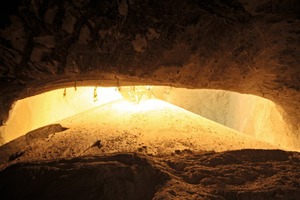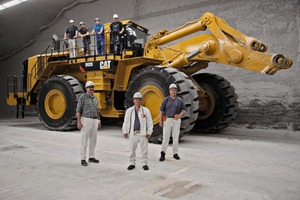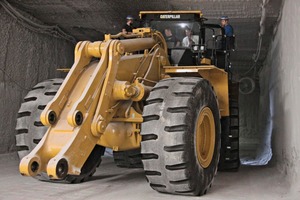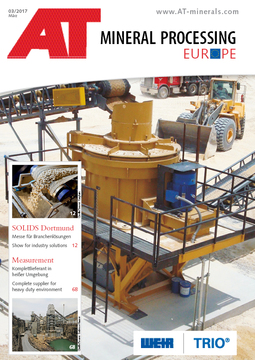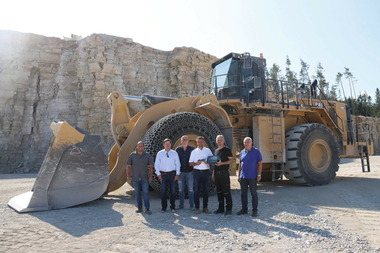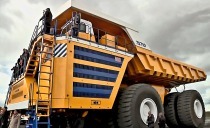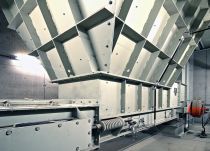Assembling a wheel loader in a potash mine
How does a Cat 992K wheel loader weighing just under 100 t get to its workplace at depth of 750 m? Not in one piece or directly. No, the construction machine had to be “finely fileted” before embarking on its journey into the underworld: there where K+S extracts crude salt in the Werra potash mine at the Hattorf site in Philippsthal, for example, for the production of fertilizer (Fig. 1). Because of the dimensions of the wheel loader – 15 m in length, 5.30 m in width and 5.00 m vehicle height, the machine first had to be completely dismantled by the supplier, Zeppelin’s Kassel branch. Then all components of the wheel loader could be transported underground via the material shaft. Large components, like the vehicle chassis, the diesel engine or the cooler unit, could be transported in one piece. On account of its size, only the bucket had to be delivered in two parts – this was welded together on site.
At a depth up to 1100 m lies the salt that K+S extracts at the Werra plant – besides Hattorf, the network includes the Wintershall, Unterbreizbach and Merker sites, which extract an average of around 25 mill. t/a crude salt. 3.2 mill. finished products are produced per year. In terms of area, the mine has now grown to the size of a city like Munich, or so the company says. 160-km-long belt conveyors transport the raw material, which is processed seven days a week, above ground. Extraction underground takes place from Monday morning to Saturday lunchtime. The crude salt is processed in a continuous operation around the clock. To cover the time window from Saturday lunchtime to Monday morning, the plant is supplied from a bin underground. The job of the new wheel loader is to transport over 11 000 t crude salt per shift from the bin and feed it to production for further processing. Its daily rate is 33 000 t. The construction vehicle works in the Hattorf flat bunker, the four chambers of which have a storage capacity of around 100 000 t crude salt.
As the routes connecting the bunker chambers measure only just over 5.00 m in height, modifications to the new Cat 992K were unavoidable to enable its use underground. These were planned down to the smallest detail (Fig. 2). At the workshop of the Zepplin branch in Kassel the wheel loader was modified as required for operation. With regard to the machine engineering, special arrangements must be made for working underground. The machine is refuelled via high-pressure, like in Formula 1 racing. 1300 l diesel can be filled in ten minutes. Because the crude salt is extracted underground, emissions must be minimized. After all, down in the mine fresh air is not always plentiful even if ventilation equipment and so-called air doors direct air to the operating site.
To keep the dust load away from the driver’s cabin, the construction vehicle was given protective ventilation, as used in the Leopard II tank. This ensures overpressure in the cabin and prevents the ingress of fine salt dust. Comfortable air conditions in the cabin are guaranteed by an air conditioning system – without this the driver would soon get into a sweat. At these depths, the temperature reaches around 30 °C. “The work is strenuous because of the poor vision conditions caused by dust formation. The driver has to really concentrate and take regular breaks,” explains Peter Budesheim, responsible for mobile machine engineering at K+S. Within one shift, the driver regularly changes over with a second driver. To ensure the machine is better protected against fine salt dust, which damages the engine in particular, the air filter was converted to a round air filter with turboseparator. This is designed to lengthen its service lifetime. Thanks to the fast-rotating fans, the coarse salt dust is thrown off before it can get into the air filter. Despite this, the filter must still be changed during a shift – the dust concentration is simply too high. One big challenge was to shorten the cabin together with the protective roof to 4.95 m – the height of the wheel loader may not exceed the 5-metre mark on account of the mine clearance. Rewiring the electronics turned out to be particularly tricky.
At the Kassel branch, after its conversion, the entire machine was dismantled, and the components picked and packaged for transport on a low loader. The logistics chain was meticulously prepared for 20 large-size components weighing more than 3 t. The heaviest component weighed 16 t. The smaller components were delivered on more than 50 pallets. All the large components were suspended above the material shaft on a heavy-duty winch with 18.1 t payload. Its diameter measures 4.50 m. None of the components could be allowed to swing or hit the wall of the shaft while they were being transported downwards. Anything heavier than 3.5 t was winched downwards slowly in 45 minutes. The tyres filled with nitrogen with an individual weight of 2.8 t could be lowered in twos. Engine, gears and cooler were heaved down in one piece. Loaders took the components to the bunker where the wheel loader was reassembled. A mobile crane was used for this.
Zeppelin led the assembly with support from the K+S team, which had the advantage that the operatives were able to learn more about the machine for later operation and maintenance. Another demand from K+S: safe working. The company has launched a strategy called Vision Zero to avoid any work accidents. Particularly tricky was the setting down and precise alignment of the heavy components. After all, these had to be aligned precisely enough for the link pins to be inserted – and all that far removed from the assembly conditions usually found in the factory.
Keenly awaited was the moment when the ignition key was turned for the first time. When the engine was started, this first rotated with the starter but without fuel so that oil pressure could be built up. Then the fuel supply was activated and the engine started running (Fig. 3). After a short warm-up phase, inspection of the systems and a visual check that all screws were tight, the loader drove the first metres.
Back in 1999, K+S had already commissioned a Cat 992G as a bunker loader. It has so far reached 32 000 operating hours and more will be added when in future it is used as back-up machine. Machine durability of the machine is particularly important in operation at K+S. As experience shows that salt in combination with water and oxygen causes corrosion, one might think that the machines in operation here are exposed to severe wear. “As long as the salt doesn’t come into contact with water and everything stays dry, nothing happens,” says Peter Budesheim. The results are shown, for example, in the wheel loader bucket. Its metal still shines and gleams as if nearly new – hardly any traces of use and wear can be seen, which is also because the salt is not abrasive. For this reason, ripper teeth or replaceable wear plates have not been fitted. The new bucket – a special construction with 32 t payload and a capacity of 22.5 m³ has only been fitted with bar plates. These have a width of 5.3 m. These are fitted to prevent deflection of the bucket shaft and thus prevent the formation of cracks. The width of the bucket makes it necessary for the attachment to be delivered in two parts in the next few weeks, transported downwards in the same way through the material shaft and then welded together underground.
There is another reason why hardly any traces of wear can be seen on the Cat 992G: “The wheel loader is our best-maintained machine. For its operational duty over two days at a time, 100 % availability is required,” says Budesheim. Especially on the weekend, the machine must perform at full functional capacity. It has to handle 1 350 t material per hour in the bunker. The machine is cherished and cared for – as soon as the smallest leak or damage is noticed, these are remedied. Once the bunker loader has loaded salt, it can only be operated in first gear to protect the tyres. It the speed is too high, they become too hot because of the extreme flexing and suffer severe wear.
K+S only lets trained machine operatives anywhere near the joysticks. With the help of Zeppelin application specialists, the company has developed its own system for driving into the heap of material. “If you drive into the material heap in the wrong way, you risk the wall falling on the loader and damaging the machine,” Budesheim explains. 20-mm-thick armoured glass panes were installed in the new Cat 992K as a precaution to protect the driver. This is not the only precaution – the Cat 992K has been equipped with an on-board extinguisher from Protectfire, which is activated automatically in an emergency. A rear-view camera and acoustic and visual warning systems alert the driver to the distance to obstacles when he is reversing the loader. But the dust formation is so immense that an extra compressor is needed to blow the dust away from the camera lens and windows. The windscreen wiper is not standard either, but has been replaced with a brush-type wiper.
By no means as comfortable is the second back-up machine: a Michigan that is operated inside the bunker electrically with 5000 volts and has to have a trailing cable that must be rolled up and unrolled. The fact that it was built in 1985 already hints at its rather rustic design, which is why it is now only used as a back-up machine – for one thing because the driver’s cabin is not glazed at all and the machine operative has to wear a sort of astronaut’s helmet. The Michigan has a handling rate of 900 t/h. To make up handling rate, it is assisted by a loader with a total height of 2.3 m, with a bucket capacity up to around 15 t. So as not to endanger the driver, the wall must first to be broken up with an around 10-m-long spike. Here a scaling jumbo comes into play. But this is completely superfluous when Cat bunker loaders like the 992K take over material loading.

